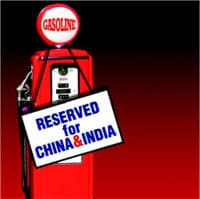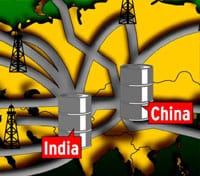Competition between Asias new economic superpowers, China and India, for energy resources has already helped push up oil prices. We look into where it could all end.

There are any number of reasons why the price of oil today is near double what it was a year ago. Some blame the hedge funds and other speculators for pushing prices to irrational levels. Others point to bottlenecks at refineries or tanker shortages. The threat of international terrorism; the situation in Iraq; potential instability in the Middle East, Nigeria, Venezuela; and the confusion following the break-up and forcible re-nationalization of Russian oil giant Yukosall have played a part.
But the reason that comes up most often is that Asias formerly sleeping giants, China and India, are now the worlds fastest-growing economies. And to sustain that growth they need to soak up just about every spare drop of oil that is not already spoken for.
They start from a low base compared to the United States and other OECD countries. The average American consumes fives times as much energy as his counterpart in India. What we see is a very significant proportion of growth in world demand for oil coming from China and India, says Fatih Birol, chief economist at the International Energy Agency (IEA) in Paris. Yet in terms of global energy consumption, the impact of Asias growing appetite for oil should not alone be sufficient to justify the current price range of $40-$50 a barrel. But with the cushion of spare production capacity worn thineither through decades of under-investment or because key OPEC players want to keep things that waythe balance between supply and demand has become fragile. In these circumstances, any perceived threat to supply pushes prices upward. And on the demand side of the equation, it is the additional energy requirements of China and India that are underpinning the new paradigm of significantly higher oil prices.
China is consuming 6 million barrels a day right now, says Leo Drollas, chief economist at the London-based Centre for Global Energy Studies, and that demand is still growing. Although a significant oil producer in its own right, around 40% of Chinas demand has to be met by imports, which rose another 31% last December to 2.9 million barrels a day. The IEAs latest forecast points to growth in Chinas oil consumption remaining above 10% a year for the foreseeable future.
India still lags behind its neighbor in terms of overall consumption. But with a population in excess of 1 billion and an economy growing at between 6% and 8% annually, it is on the way to becoming one of the worlds leading energy consumers. It is widely expected that Indias energy requirements will treble over the next 15 years.
Still, it is mainly Chinas increasing dependence on oil imports that underpins high prices. Whereas oil accounted for 29% of Chinas energy needs in 2000, that is set to rise above 50% within the next five years. Chinese demand is the biggest driver in international oil markets, says Drollas. It is likely to remain so for some time to come, he adds. According to the IEAs deliberately moderate forecasts, China will be the worlds second-largest oil importer before the year 2030, bringing in around 10 million barrels a dayor roughly the same volume as the US currently imports.
Search For Resources

So where is all that extra oil going to come from? Chinas domestic oil production has plateaued and, unless there are major new discoveries, is expected to trend downward over the next decade. Just such a major discovery was made in India last year, with the Cairn Group opening up the worlds largest new oil field in Rajasthan. India is also increasing its spending on offshore oil and gas exploration and has already made important finds in the Bay of Bengal. Against that, India already imports 75% of its oil, and domestic production would have to more than double year on year to keep pace with growing demand. With both China and India we expect demand will be met increasingly through their importing oilmainly from the Middle East, says the IEAs Birol.
But given the potential for disruption of supplies from the Middle East, whether through terrorist attacks or more general political instability, the two big Asian importers are seeking to secure energy resources from elsewhere. Indias state-owned companies now have a mandate from government to search for energy assets abroad, says Praveen Martis, Middle East and South Asia analyst at research group Wood McKenzie. There is definitely a thrust to reduce dependence on a small number of sources, Martis adds.
That explains why Indian oil companies are now submitting tenders for oil and gas contracts all around the globe, from Venezuela to South East Asia. Yet, as comparative latecomers in the global oil stakes, both India and China have to compete for whatever is available. Very often they go head-to-headas in Angola, where Indias Oil and Natural Gas Corporation (ONGC) put in a bid to Shell to purchase rights to an offshore block, only to be outflanked by Chinas offer of a $2 billion aid package to the Angolan government to secure the same assets.
The two Asian behemoths are also in direct competition for a slice of vast oil and gas reserves in Russia that used to be operated by Yukos but were recently handed over to the state-owned Rosneft. China appeared to have the upper hand in this race when Russias energy minister, Viktor Khristenko, announced that 20% of the main production unit, Yuganskneftgas, would be offered to China National Petroleum Corporation. But, just one week later, Indias ONGC declared it planned to make a $2 billion bid for a 15% stake in the same company. The outcome of this battle for Siberias immense reserves remains uncertainparticularly as the legality of re-nationalizing Yukoss assets is being contested in US courtrooms. And although Russia represents the richest prize, having the largest proven reserves outside of OPEC, India and China are competing fiercely for oil and gas in Iran, Venezuela and practically any other oil-producing nation with assets for sale. In order to outbid commercial oil companies, they are having to pay top dollar for assets that the oil majors would not look at twice.
They are nibbling around at the edges because even the largest of these state-owned companies doesnt have the muscle of ExxonMobil, Shell or BP, says Drollas. And while they have certainly brought a new edge of competition into bidding for long-term contracts, the assets currently available are often only of secondary importance and therefore unlikely to alter the overall market balance.
Its all small beer, comments Drollas, adding that the real problem is that companies that have the cash, including Chinese and Indian state-owned companies, cannot gain access to where most of the oil is. Theyre not allowed into Saudi Arabia or Iraq, and the attitude among other producer nations towards their energy assets is becoming very nationalisticwitness Russias recent announcement about limiting foreign investment in energy and other strategic industries. And most of the Gulf countries are not very keen on long-term contracts beyond a year out, Drollas adds. So the options available to India and Chinas aspiring oil companies are looking distinctly limited.
In order to reduce their dependency on Middle Eastern crude, both India and China are seeking to diversify their energy mix away from oil. China has long been engaged in so-called pipeline diplomacy to bring in natural gas from Siberia and the Caspian basin and more recently has embarked on a massive investment program for LNG (liquefied natural gas) import facilities along its eastern and southern coastlines.
India is likewise seeking to build pipelines bringing in gas from Myanmar and Bangladesh to the east. Even more politically sensitive is the so-called pipeline for peace, which would allow Indias growing market to link into major gas fields in eastern Iran. But that would have to traverse neighboring Pakistan, whose often-hostile relationship with India might preclude any genuine security of supply.
Again, both countries have immense domestic coal reserves that they would like to see playing a larger part in meeting overall energy demand. For the present, outdated mines and transport infrastructure prevent full utilization of these assets. Also, there are serious environmental drawbacks in burning more coal. Even though neither China nor India have signed up to the Kyoto protocol, they are fully aware that they cannot continue to ignore climate change issues in the long term.
China has embarked on an ambitious nuclear power generation program, and both countries are expanding their hydro-capacity and renewable sources of energy. Unfortunately, none of this will quench their growing thirst for oil. Automobiles run on gasoline, and as yet there is no viable substitute (though with Japanese assistance, China is rapidly becoming a world leader in hybrid electric/diesel-powered vehicles). The coming explosion of Chinese car ownership as the new prosperity spreads outward from the eastern seaboard can only exacerbate the problem.
India is expecting much the same, although starting from a lower base line. Car ownership is expected to increase from current levels of just nine cars per thousand people to 24 per thousand over the next decade. Among the reasons for further oil demand growth in both countries, Birol points to the very low levels of vehicle ownership combined with rising affluence and consumer confidence.
Unless they experience a major slow-down in economic growth, the Asian giants will be siphoning off an increasing share of global energy supply. While they are actively seeking long-term contracts, the opportunities currently available do not match their likely requirements. As a result, both countries are increasingly concerned about security of supply. We are seeing an increasing emphasis in both China and India on building up strategic stocks, observes Birol. That may help tide over any short-term dislocation to normal supplies arising from international conflict or terrorism, but it offers no protection whatsoever against sudden surges or spikes in oil prices. At their current levels, the reserves of China and India are just peanuts compared to global volumes, says Birol. They cant put any pressure on world oil supply or prices.
In India, says Martis, energy security has gone high up in the list of government priorities. There are three main components in this: altering the energy mix towards domestic production, which in India is mainly coal; increasing storage capacity; and building up a strategic reserve. There is a strategy in place to have a strategic reserve for oil by 2007.
Drollas adds: They are looking for security of supply, but thats a pipe-dream. No country has been able to achieve that. The best security of supply, he adds, is either to produce your own oil or to source imports from as many different countries as possible. Both India and China have taken those lessons on board, but the opportunities to either raise domestic output or diversify imports remain limited.
The only other option is to curb consumption through greater energy efficiency or doing away with subsidies that have previously inflated demand. The rapid upsurge in Asias energy consumption is not all it seems, says Drollas. Indian demand is underpinned by government subsidies on kerosene. But with the country running a massive $4 billion deficit on the oil account, those subsidies might have to be reviewed.
That creates a big political hurdle, according to Martis, because Indian consumers are used to subsidized gas prices. Besides which, cheap kerosene is promoted as a means of dissuading rural dwellers from burning wood or other biomass fuels. But if India wishes to reduce its dependency on oil by increasing the amount of natural gaseither as LNG or delivered by proposed new pipelinesit will have to pay the market price, which is significantly higher than what its consumers are accustomed to.
Potential For Efficiency

There is plenty of room for China to become more energy-efficient. Currently it consumes five times as much energy per unit of output as does Japan. That is partly due to outdated industrial plant, though the countrys creaking energy infrastructure is also to blame.
With Chinas centrally planned economy, oil consumption is more closely linked to the power sector than elsewhere, says Drollas. And while coal-fired power stations provide for most of electricity generation, the existing infrastructure is not up to meeting rapidly growing demand. As Catriona Scott, Asia and Pacific analyst at Wood McKenzie, sees it, A lack of sufficient coal production and transportation infrastructure continued to be a problem in 2004 and was one of the causes of widespread power shortages.
Indeed, the frequency and duration of blackouts has increased to the point that most power-sensitive industriesand more affluent consumersnow rely on diesel generators as a back-up. All of which only adds to Chinas oil imports bill. But resorting to such oil-hungry, stopgap measures should become unnecessary once Chinas massive investments in power stations and grid networks come on stream. Oil demand has been through a very exuberant patch, says Drollas, but that is not going to continue indefinitely. It never does.
Temporary inefficiencies and market distortions may soon be ironed out, allowing some scaling down of forecast energy demand in both countries. That said, the emergence of China and India as economic superpowers is changing the entire structure of global energy markets. They are major players and will make their weight felt.
Jonathan Gregson



